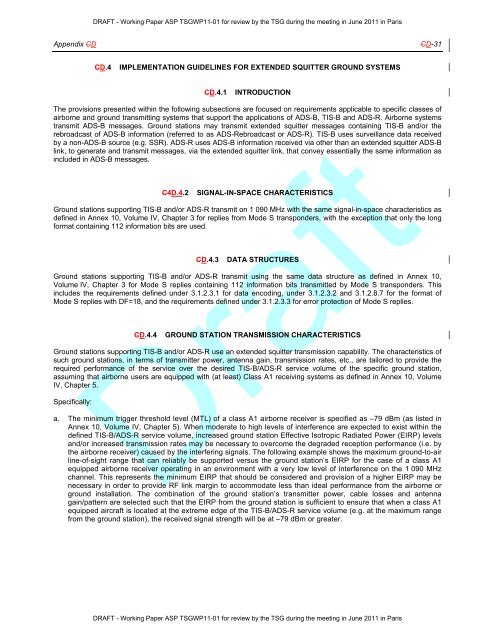Technical Provisions for Mode S Services and Extended Squitter
Technical Provisions for Mode S Services and Extended Squitter
Technical Provisions for Mode S Services and Extended Squitter
You also want an ePaper? Increase the reach of your titles
YUMPU automatically turns print PDFs into web optimized ePapers that Google loves.
Appendix CD CD-31<br />
CD.4 IMPLEMENTATION GUIDELINES FOR EXTENDED SQUITTER GROUND SYSTEMS<br />
CD.4.1 INTRODUCTION<br />
The provisions presented within the following subsections are focused on requirements applicable to specific classes of<br />
airborne <strong>and</strong> ground transmitting systems that support the applications of ADS-B, TIS-B <strong>and</strong> ADS-R. Airborne systems<br />
transmit ADS-B messages. Ground stations may transmit extended squitter messages containing TIS-B <strong>and</strong>/or the<br />
rebroadcast of ADS-B in<strong>for</strong>mation (referred to as ADS-Rebroadcast or ADS-R). TIS-B uses surveillance data received<br />
by a non-ADS-B source (e.g. SSR). ADS-R uses ADS-B in<strong>for</strong>mation received via other than an extended squitter ADS-B<br />
link, to generate <strong>and</strong> transmit messages, via the extended squitter link, that convey essentially the same in<strong>for</strong>mation as<br />
included in ADS-B messages.<br />
C4D.4.2 SIGNAL-IN-SPACE CHARACTERISTICS<br />
Ground stations supporting TIS-B <strong>and</strong>/or ADS-R transmit on 1 090 MHz with the same signal-in-space characteristics as<br />
defined in Annex 10, Volume IV, Chapter 3 <strong>for</strong> replies from <strong>Mode</strong> S transponders, with the exception that only the long<br />
<strong>for</strong>mat containing 112 in<strong>for</strong>mation bits are used.<br />
CD.4.3 DATA STRUCTURES<br />
Ground stations supporting TIS-B <strong>and</strong>/or ADS-R transmit using the same data structure as defined in Annex 10,<br />
Volume IV, Chapter 3 <strong>for</strong> <strong>Mode</strong> S replies containing 112 in<strong>for</strong>mation bits transmitted by <strong>Mode</strong> S transponders. This<br />
includes the requirements defined under 3.1.2.3.1 <strong>for</strong> data encoding, under 3.1.2.3.2 <strong>and</strong> 3.1.2.8.7 <strong>for</strong> the <strong>for</strong>mat of<br />
<strong>Mode</strong> S replies with DF=18, <strong>and</strong> the requirements defined under 3.1.2.3.3 <strong>for</strong> error protection of <strong>Mode</strong> S replies.<br />
CD.4.4 GROUND STATION TRANSMISSION CHARACTERISTICS<br />
Ground stations supporting TIS-B <strong>and</strong>/or ADS-R use an extended squitter transmission capability. The characteristics of<br />
such ground stations, in terms of transmitter power, antenna gain, transmission rates, etc., are tailored to provide the<br />
required per<strong>for</strong>mance of the service over the desired TIS-B/ADS-R service volume of the specific ground station,<br />
assuming that airborne users are equipped with (at least) Class A1 receiving systems as defined in Annex 10, Volume<br />
IV, Chapter 5.<br />
Specifically:<br />
DRAFT - Working Paper ASP TSGWP11-01 <strong>for</strong> review by the TSG during the meeting in June 2011 in Paris<br />
Draft<br />
a. The minimum trigger threshold level (MTL) of a class A1 airborne receiver is specified as –79 dBm (as listed in<br />
Annex 10, Volume IV, Chapter 5). When moderate to high levels of interference are expected to exist within the<br />
defined TIS-B/ADS-R service volume, increased ground station Effective Isotropic Radiated Power (EIRP) levels<br />
<strong>and</strong>/or increased transmission rates may be necessary to overcome the degraded reception per<strong>for</strong>mance (i.e. by<br />
the airborne receiver) caused by the interfering signals. The following example shows the maximum ground-to-air<br />
line-of-sight range that can reliably be supported versus the ground station’s EIRP <strong>for</strong> the case of a class A1<br />
equipped airborne receiver operating in an environment with a very low level of interference on the 1 090 MHz<br />
channel. This represents the minimum EIRP that should be considered <strong>and</strong> provision of a higher EIRP may be<br />
necessary in order to provide RF link margin to accommodate less than ideal per<strong>for</strong>mance from the airborne or<br />
ground installation. The combination of the ground station’s transmitter power, cable losses <strong>and</strong> antenna<br />
gain/pattern are selected such that the EIRP from the ground station is sufficient to ensure that when a class A1<br />
equipped aircraft is located at the extreme edge of the TIS-B/ADS-R service volume (e.g. at the maximum range<br />
from the ground station), the received signal strength will be at –79 dBm or greater.<br />
DRAFT - Working Paper ASP TSGWP11-01 <strong>for</strong> review by the TSG during the meeting in June 2011 in Paris
















